Interface Characterization of Current-Perpendicular-to-Plane Spin Valves Based on Spin Gapless Semiconductor Mn2CoAl
Abstract
:Featured Application
Abstract
1. Introduction
2. Calculation Methods
3. Result and Discussion
4. Conclusions
Author Contributions
Funding
Conflicts of Interest
References
- Wolf, S.A.; Awschalom, D.D.; Buhrman, R.A.; Daughton, J.M.; von Molnár, S.; Roukes, M.L.; Chtchelkanova, A.Y.; Treger, D.M. Spintronics: A spin-based electronics vision for the future. Science 2001, 294, 1488–1495. [Google Scholar] [CrossRef] [PubMed]
- Li, X.; Yang, J. First-principles design of spintronics materials. Natl. Sci. Rev. 2016, 3, 365–381. [Google Scholar] [CrossRef]
- Nakatani, T.M.; Furubayashi, T.; Kasai, S.; Sukegawa, H.; Takahashi, Y.K.; Mitani, S.; Hono, K. Bulk and interfacial scatterings in current-perpendicular-to-plane giant magnetoresistance with Co2Fe(Al0.5Si0.5) Heusler alloy layers and Ag spacer. Appl. Phys. Lett. 2010, 96, 212501. [Google Scholar] [CrossRef]
- Childress, J.R.; Carey, M.J.; Cyrille, M.C.; Carey, K.; Smith, N.; Katine, J.A.; Boone, T.D.; Driskill-Smith, A.A.G.; Maat, S.; Mackay, K.; et al. Fabrication and recording study of all-metal dual-spin-valve CPP read heads. IEEE Trans. Magn. 2006, 42, 2444–2446. [Google Scholar] [CrossRef]
- Graf, T.; Felser, C.; Parkin, S.S.P. Simple rules for the understanding of Heusler compounds. Prog. Solid State Chem. 2011, 39, 1–50. [Google Scholar] [CrossRef]
- Felser, C.; Fecher, G.H. (Eds.) Spintronics; Springer: Berlin, Germany, 2013. [Google Scholar]
- Galanakis, I.; Dederichs, P. (Eds.) Half-metallicity and Slater-Pauling behavior in the ferromagnetic Heusler alloys. In Half-Metallic Alloys; Springer: Berlin, Germany, 2005. [Google Scholar]
- Feng, Y.; Chen, H.; Yuan, H.K.; Zhou, Y.; Chen, X. The effect of disorder on electronic and magnetic properties of quaternary Heusler alloy CoFeMnSi with LiMgPbSb-type structure. J. Magn. Magn. Mater. 2015, 378, 7–15. [Google Scholar] [CrossRef]
- Wang, X.T.; Cheng, Z.; Liu, G.; Dai, X.; Rabah, K.; Wang, L.; Bouhemadou, A. Rare earth-based quaternary Heusler compounds MCoVZ (M = Lu, Y; Z = Si, Ge) with tunable band characteristics for potential spintroic applications. IUCrJ 2017, 4, 758–768. [Google Scholar] [CrossRef] [PubMed]
- Jourdan, M.; Minár, J.; Braum, J.; Kronenerg, A.; Chadov, S.; Balke, B.; Gloskovskii, A.; Kolbe, M.; Elmers, H.J.; Schönhense, G.; et al. Direct observation of half-metallicity in the Heusler compound Co2MnSi. Nat. Commun. 2014, 5, 3974. [Google Scholar] [CrossRef] [PubMed]
- Galanakis, I.; Dederichs, P.H.; Papanikolaou, N. Slater-Pauling behavior and origin of the half-metallicity of the full-Heusler alloys. Phys. Rev. B 2002, 66, 174429. [Google Scholar] [CrossRef]
- Takahashi, Y.K.; Hase, N.; Kodzuka, M.; Itoh, A.; Koganezawa, T.; Furubayashi, T.; Li, S.; Varaprasad, B.S.D.C.S.; Ohkubo, T.; Hono, K. Structure and magnetoresistance of current-perpendicular-to-plane pseudo spin valves using Co2Mn(Ga0.25Ge0.75) Heusler alloy. J. Appl. Phys. 2013, 113, 223901. [Google Scholar] [CrossRef]
- Sakuraba, Y.; Ueda, M.; Miura, Y.; Sato, K.; Bosu, S.; Saito, K.; Shirai, M.; Konno, T.; Takanashi, K. Extensive study of giant magnetoresistance properties in half-metallic Co2(Fe,Mn)Si-based devices. J. Appl. Phys. Lett. 2012, 101, 252408. [Google Scholar] [CrossRef]
- Sakuraba, Y.; Izumi, K.; Miura, Y.; Futasukawa, K.; Iwase, T.; Bosu, S.; Saito, K.; Abe, K.; Shirai, M.; Takanashi, K. Mechanism of large magnetoresistance in Co2MnSi/Ag/Co2MnSi devices with current perpendicular to the plane. Phys. Rev. B 2010, 82, 094444. [Google Scholar] [CrossRef]
- Li, S.; Takahashi, Y.K.; Furubayashi, T.; Hono, K. Enhancement of giant magnetoresistance by L21 ordering in Co2Fe(Ge0.5Ga0.5) Heusler alloy current-perpendicular-to-plane pseudo spin valves. Appl. Phys. Lett. 2013, 103, 042405. [Google Scholar] [CrossRef]
- Skaftouros, S.; Özdoğan, K.; Şaşioğlu, E.; Galanakis, I. Generalized Slater-Pauling rule for the inverse Heusler compounds. Phys. Rev. B 2013, 87, 024420. [Google Scholar] [CrossRef]
- Feng, L.; Tang, C.; Wang, S.; He, W. Half-metallic full-Heusler compound Ti2NiAl: A first-principles study. J. Alloy. Compd. 2011, 509, 5187–5189. [Google Scholar]
- Feng, Y.; Wu, B.; Yuan, H.K.; Kuang, A.L.; Chen, H. Magnetism and half-metallicity in bulk and (1 0 0) surface of Heusler alloy Ti2CoAl with Hg2CuTi-type structure. J. Alloy. Compd. 2013, 557, 202–208. [Google Scholar] [CrossRef]
- Jakobsson, A.; Mavropoulos, P.; Şaşioğlu, E.; Blügel, S.; Ležaić, M.; Sanyal, B.; Galanakis, I. First-principles calculations of exchange interactions, spin waves, and temperature dependence of magnetization in inverse-Heusler-based spin gapless semiconductors. Phys. Rev. B 2015, 91, 174439. [Google Scholar] [CrossRef]
- Ouardi, S.; Fecher, G.H.; Felser, C.; Kübler, J. Realization of Spin Gapless Semiconductors: The Heusler Compound Mn2CoAl. Phys. Rev. Lett. 2013, 110, 100401. [Google Scholar] [CrossRef] [PubMed]
- Galanakis, I.; Özdoğan, K.; Şaşıoğlu, E.; Blügel, S. Conditions for spin-gapless semiconducting behavior in Mn2CoAl inverse Heusler compound. J. Appl. Phys. 2014, 115, 093908. [Google Scholar] [CrossRef]
- Jamer, M.E.; Assaf, B.A.; Devakul, T. Magnetic and transport properties of Mn2CoAl oriented films. Appl. Phys. Lett. 2013, 103, 142403. [Google Scholar] [CrossRef]
- Xu, G.Z.; Du, Y.; Zhang, X.M.; Zhang, H.G.; Liu, E.K.; Wang, W.H.; Wu, G.H. Magneto-transport properties of oriented Mn2CoAl films sputtered on thermally oxidized Si substrates. Appl. Phys. Lett. 2014, 104, 242408. [Google Scholar] [CrossRef]
- Skaftouros, S.; Özdoğan, K.; Şaşioğlu, E.; Galanakis, I. Search for spin gapless semiconductors: The case of inverse Heusler compounds. Appl. Phys. Lett. 2013, 102, 022402. [Google Scholar] [CrossRef] [Green Version]
- Wang, X.L. Proposal for a new class of materials: Spin gapless semiconductors. Phys. Rev. Lett. 2008, 100, 156404. [Google Scholar] [CrossRef] [PubMed]
- Feng, Y.; Zhou, T.; Chen, X.; Yuan, H.K.; Chen, H. Thermodynamic stability, magnetism and half metallicity of Mn2CoAl/GaAs (0 0 1) interface. J. Phys. D Appl. Phys. 2015, 48, 285302. [Google Scholar] [CrossRef]
- Zarei, S.; Hashemifar, S.J.; Akbarzadeh, H.; Hafari, H.J. Half-metallicity at the Heusler alloy Co2Cr0.5Fe0.5Al (001) surface and its interface with GaAs (001). Phys. Condens. Matter 2009, 21, 055002. [Google Scholar] [CrossRef] [PubMed]
- Perdew, J.P.; Burke, K.; Ernzerhof, M. Generalized gradient approximation made simple. Phys. Rev. Lett. 1996, 77, 3865–3868. [Google Scholar] [CrossRef] [PubMed]
- Blöchl, P.E. Projector augmented-wave method. Phys. Rev. B 1994, 50, 17953. [Google Scholar] [CrossRef]
- Ghader, N.; Hashemifar, S.J.; Akbarzadeh, H.; Peressi, M. First principle study of Co2MnSi/GaAs(001) heterostructures. J. Appl. Phys. 2007, 102, 074306. [Google Scholar] [CrossRef]
- Taylor, J.; Guo, H.; Wang, J. Ab initio modeling of quantum transport properties of molecular electronic devices. Phys. Rev. B 2001, 63, 245407. [Google Scholar] [CrossRef] [Green Version]
- Waldron, D.; Haney, P.; Larade, B.; MacDonald, A.; Guo, H. Nonlinear spin current and magnetoresistance of molecular tunnel junctions. Phys. Rev. Lett. 2006, 96, 166804. [Google Scholar] [CrossRef] [PubMed]
- Burrows, C.W.; Bastiman, S.A.; Bell, G.R. Interaction of Mn with GaAs and InSb: Incorporation, surface reconstruction and nano-cluster formation. J. Phys. Condens. Matter 2014, 26, 395006. [Google Scholar] [CrossRef] [PubMed]
- Feng, Y.; Chen, X.; Zhou, T.; Yuan, H.K.; Chen, H. Structural stability, half-metallicity and magnetism of the CoFeMnSi/GaAs (0 0 1) interface. Appl. Surf. Sci. 2015, 346, 1–10. [Google Scholar] [CrossRef]
- Van de Walle, C.G.; Neugebauer, J. First-principles calculations for defects and impurities: Applications to III-nitrides. J. Appl. Phys. 2004, 95, 3851. [Google Scholar] [CrossRef]
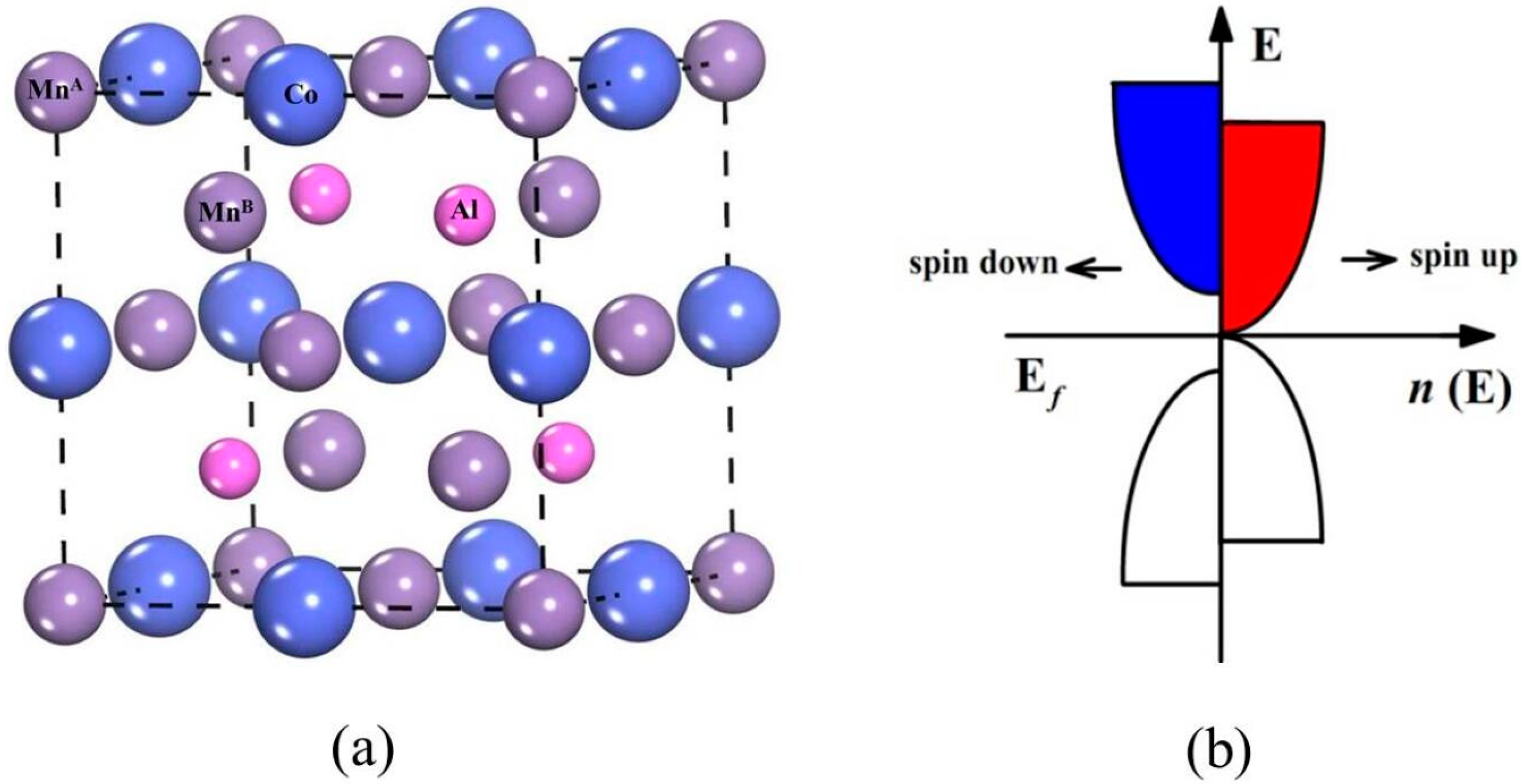


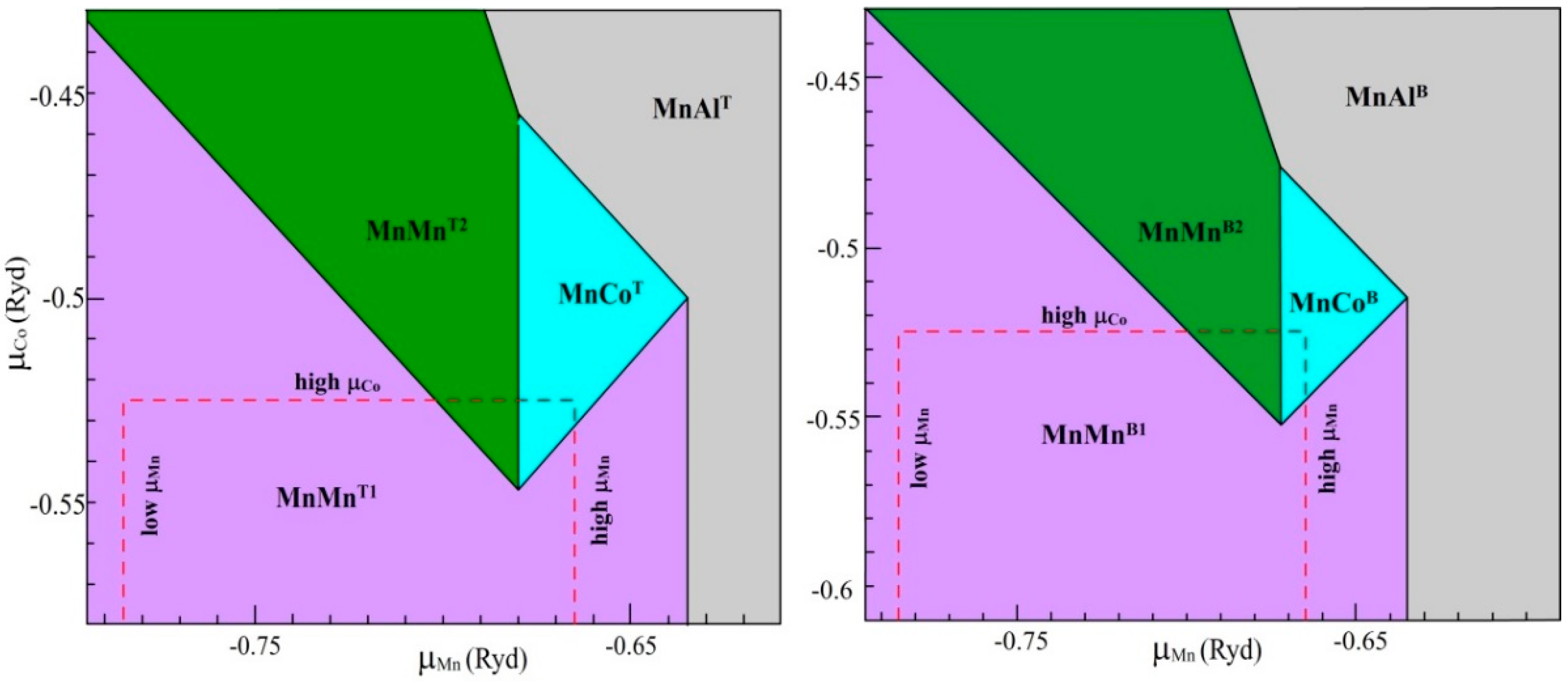
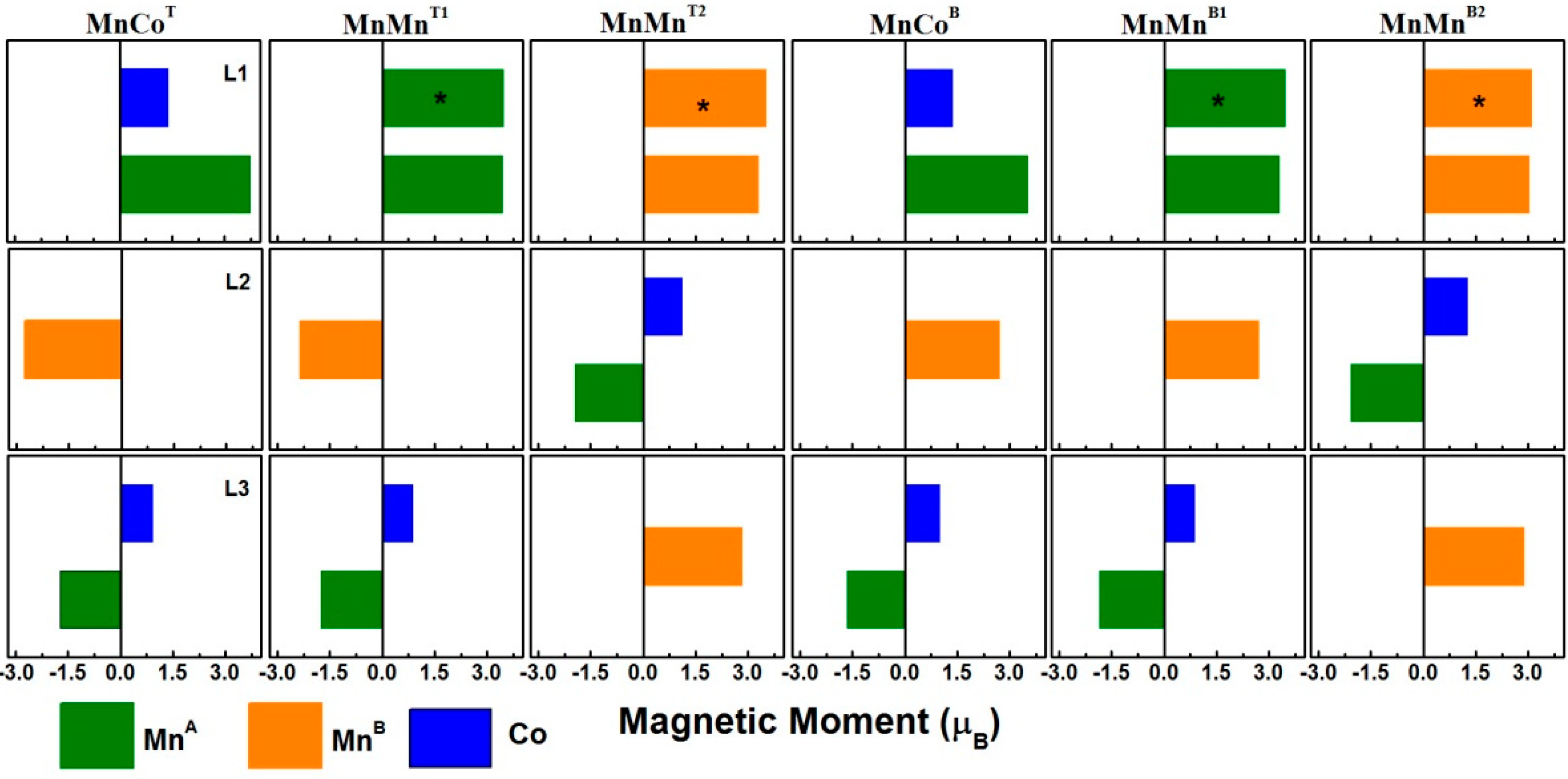

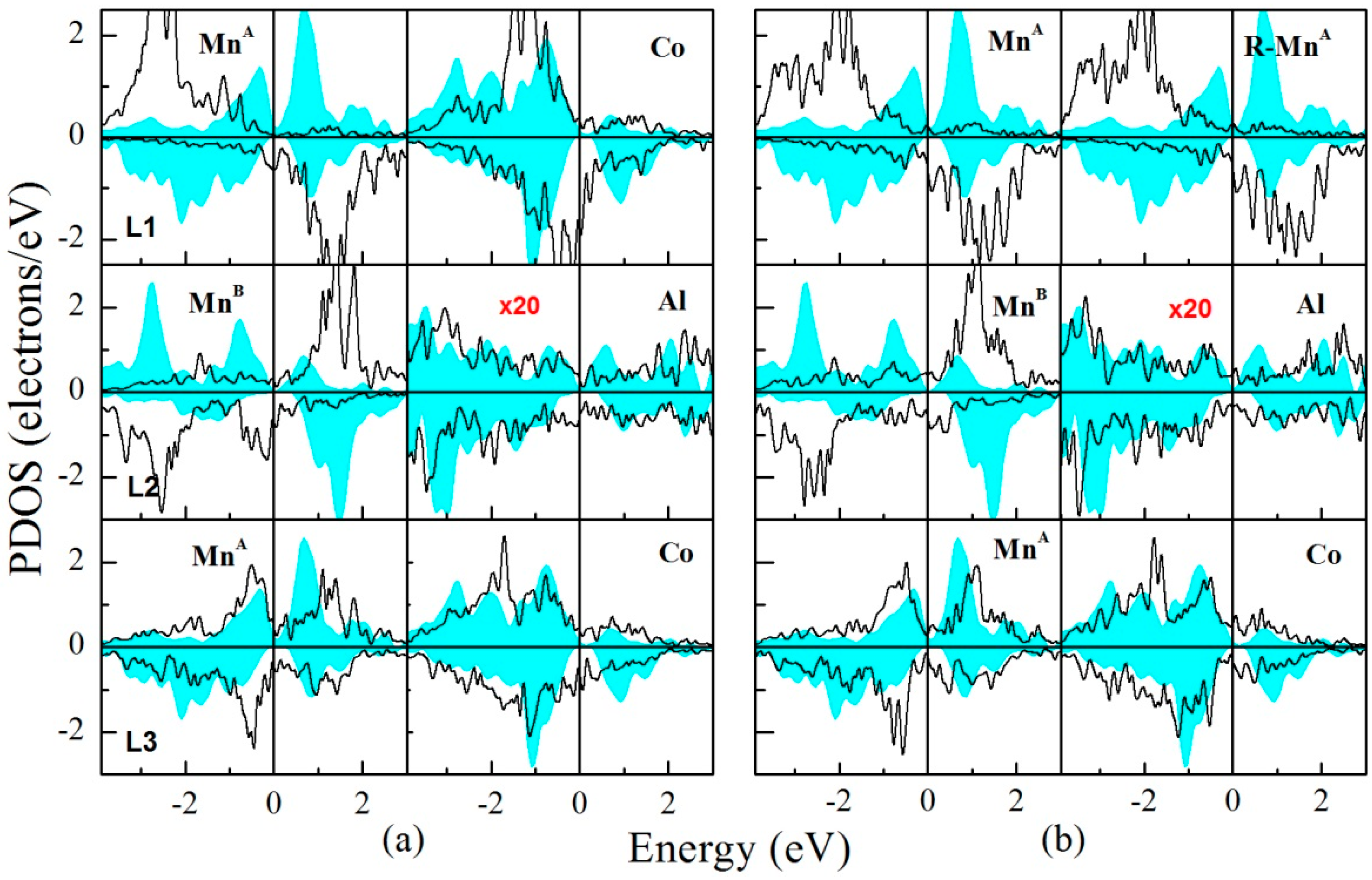
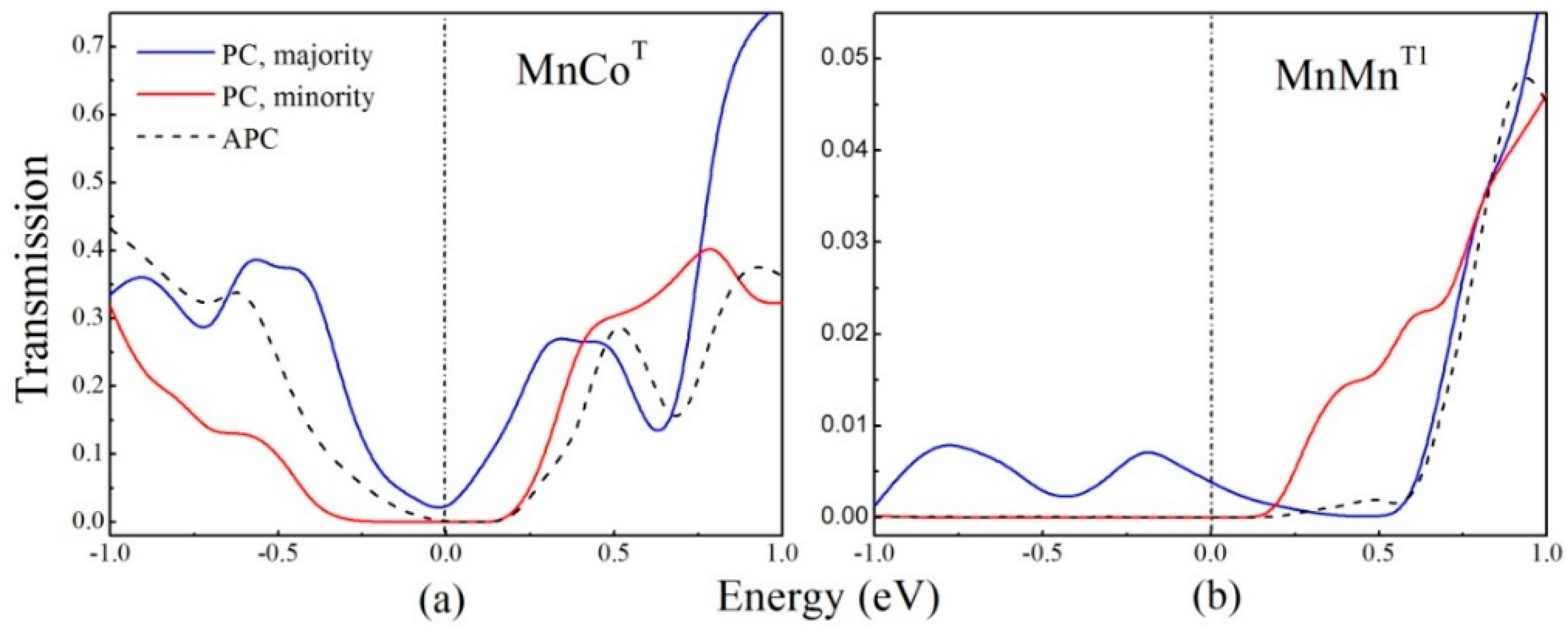

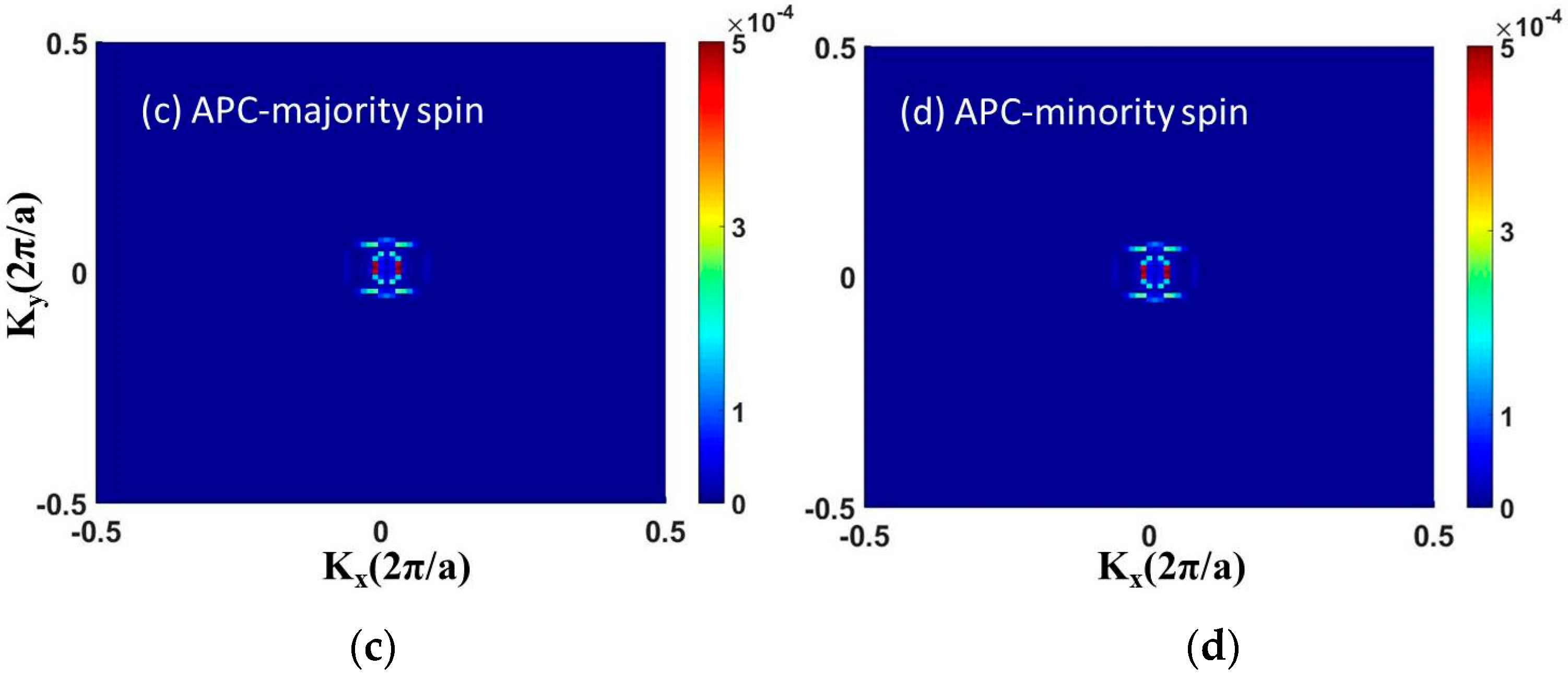
© 2018 by the authors. Licensee MDPI, Basel, Switzerland. This article is an open access article distributed under the terms and conditions of the Creative Commons Attribution (CC BY) license (http://creativecommons.org/licenses/by/4.0/).
Share and Cite
Wei, M.-S.; Cui, Z.; Ruan, X.; Zhou, Q.-W.; Fu, X.-Y.; Liu, Z.-Y.; Ma, Q.-Y.; Feng, Y. Interface Characterization of Current-Perpendicular-to-Plane Spin Valves Based on Spin Gapless Semiconductor Mn2CoAl. Appl. Sci. 2018, 8, 1348. https://doi.org/10.3390/app8081348
Wei M-S, Cui Z, Ruan X, Zhou Q-W, Fu X-Y, Liu Z-Y, Ma Q-Y, Feng Y. Interface Characterization of Current-Perpendicular-to-Plane Spin Valves Based on Spin Gapless Semiconductor Mn2CoAl. Applied Sciences. 2018; 8(8):1348. https://doi.org/10.3390/app8081348
Chicago/Turabian StyleWei, Ming-Sheng, Zhou Cui, Xin Ruan, Qi-Wen Zhou, Xiao-Yi Fu, Zhen-Yan Liu, Qian-Ya Ma, and Yu Feng. 2018. "Interface Characterization of Current-Perpendicular-to-Plane Spin Valves Based on Spin Gapless Semiconductor Mn2CoAl" Applied Sciences 8, no. 8: 1348. https://doi.org/10.3390/app8081348




